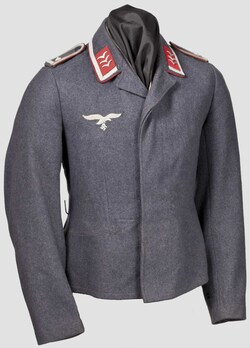Luftwaffe Flight Blouse (Other Ranks version; 1935-1940)
CATEGORY: Version
SKU: 22.GOR.2100.012.00.002
Estimated market value:

Estimated market value:
The German Wehrmacht was composed of three main branches, the Heer, the Kriegsmarine, and the Luftwaffe. The Heer and Kriegsmarine uniforms were based upon the designs utilized by their predecessor organizations, the Deutsches Heer and the Kaiserliche Marine. Conversely, the Luftwaffe uniforms were based upon the uniforms worn in the sports and para-military organizations that were the forerunners of the Luftwaffe. The Luftwaffe uniforms were specifically designed to deviate from the designs of the other Wehrmacht service branches. It was also necessary that the uniforms differentiate between military and civilian pilots.
There were two main organizational precursors of the Luftwaffe, the German Air Sports Association (DLV or Deutscher Luftsportverband), and the National Air Raid Protection League (RLB or Reichs Luftschutzbund). The DLV included both a civilian group and a secret military sub-group called the DLV-Fliegerschaft (Pilot Base).
The DLV and the RLB were officially founded in 1933, and they were used to secretly train members for future roles in the Luftwaffe. The DLV became obsolete after Hitler’s official introduction of the Luftwaffe in 1935, and it was disbanded in 1937.
The Flight Blouse was introduced for wear by all ranks of the Luftwaffe while performing flight duties.
This tunic is single-breasted and composed of several main elements, including the cloth, the pockets, the buttons, and the additional insignia.
The tunic is made of blue-grey cloth, which may be of a higher quality if the tunic was purchased privately by Officers and Senior Non-Commissioned Officers.
There are two main versions of this tunic: the 1st pattern tunics were produced prior to 1940, while the 2nd pattern tunics were produced after 1940.
All 1st pattern tunics feature built-in belt hooks. The 1st pattern Officer and General tunics feature curved side pockets without any covering, an embroidered Luftwaffe pattern national emblem eagle on the right breast, and piping on the collar. For Generals, the piping is composed of gold-colour (gilt) twisted cord. For Officers, the piping is composed of silver-coloured (aluminum) twisted cord.
The 1st pattern NCO/EM (Non-Commissioned Officers/Enlisted Men) tunics do not have any external pockets, do not feature the national emblem eagle, but do feature piping on the collar. The colour of the piping on these tunics matches the wearer’s arm of service (Waffenfarbe).
A simplified overview of the Waffenfarbe colours follows. Not all of these will appear on the NCO/EM blouses.
White: General Officers
Golden-Yellow: Flying Troops (Fliegertruppe)
Red: Anti-Aircraft Troops/Luftwaffe Artillery
Brown: Luftwaffe Signals/Communication Corps (Luftnachrichtentruppe)
Black: Reich Air Ministry, Construction Engineer Corp (Baupioniere) or Luftwaffe Engineer Corp (Luftwaffen-Pioniere)
Dark Green: Administration (Militärverwaltung)
Light/Meadow Green: Radar Units and Air Traffic Control
Dark Blue: Luftwaffe Medical Corps (Sanitätstruppe)
Light Blue: Transport Units (Transporteinheiten) or Luftwaffe Reserve
Carmine: General Staff Service Officers (Generalstabsoffiziere) and Veterinary NCOs/EMs
Pink: Corps of Engineer Officers (Ingenieuroffizierkorps)
Wine Red: Military Judicial Officers (Militärgerichtsbarkeit)
The 2nd pattern tunics do not have built-in belt hooks. The 2nd pattern General and Officer tunics do not feature any significant changes in design. Conversely, the 2nd pattern NCO/EM tunics were altered, wherein the colour piping was removed, and an embroidered Luftwaffe pattern national emblem eagle and shallow pockets were added to the tunic design.
These tunics do not feature any external buttons. Instead, the buttons are covered by a long strip of cloth so that they would not catch on any instruments in the aircraft.

Comments
Sign in to comment and reply.


Scroll Top